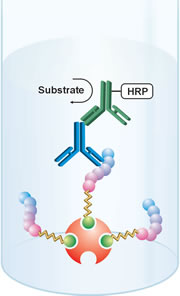R&D Applications
Some of the most common uses of PepSets are listed below.
Immunology 1,2
The most common use of PepSets in immunology is for B-cell and T-cell linear epitope mapping. Table 1 is an overview of the design guidelines for epitope mapping.
| Purpose | Cytotoxic T-cells | Helper T-cells |
Antibodies |
| Peptide Length (No. of Amino Acids) | 9 to 20 | 13 to 25 | 6 to 20 |
| Number of overlapping amino acids | Not less than 8 | Not less than 12 | Not less than 5 |
| N-terminus | Free amine | Free amine | Biotinylated with spacer, or acetylated |
| C-terminus | Free acid | Free acid or amine | Amide or noncleavable |
Pharmacology/Physiology 3
The most common use of PepSets in pharmacology/physiology is for locating or analoging of pharmacologically active peptides such as neurotransmitters, hormones or chemokines. Table 2 lists common designs.
| Purpose | Primary Scanning | Narrowing Down | Analoging (SAR) |
| Peptide Length (No. of Amino Acids) | 5 to 20 | Reduce by one AA from each end | Replace one AA at a time |
| Number of overlapping amino acids | 4 to 19 | 100% | 100% |
Biochemistry 4,5
PepSets are used in biochemical studies as enzyme substrates, inhibitors, or ligands. Table 3 covers some of the possibilities.
| Application | Peptide Design Feature |
| Protease substrates | Reporter groups (FRET, fluorescence polarization) |
| Phosphorylation substrate | Capture group or tag |
| Inhibitor library | Unnatural amino acid, nonpeptide bond or chemical grouping |
| Binding ligands | Reporter or capture group |
Molecular Biology 6,7
Peptide libraries can be used to look for the sites of protein-protein or protein-nucleic acid interaction. Testing can be by direct capture of the protein or nucleic acid, by measurement of captured peptide, or by inhibition of another known binding interaction (Table 4). Protein sequences can be screened for interaction sites by making panels of antipeptide antibodies covering the whole protein (Table 5).
| Measurement Method | Peptide Design Feature |
| Direct capture of macromolecule | Biotinylated or noncleavable peptides |
| Measure captured peptide | Biotinylated or fluorescent peptide |
| Inhibit known interaction | No peptide modification required |
| Design Feature | Peptide Design Feature |
| Peptide length (No. of Amino Acids) |
8 to 24 |
| Number of overlapping Amino Acids | 7 or more |
| N-terminus | Conjugation group (sulfhydryl) + biotin |
| C-terminus | DKP (linker) |
| Method of use | Simultaneous cleavage and conjugation |
|
Immunodiagnostic Test and Vaccine Development 8,9
Preliminary screening of all possible sites for effectiveness of antipeptide antibodies in a disease model can lead directly to the best vaccine candidates and save years of expensive “trial and error” research based on predictive methods (Table 5). Likewise, immunodiagnostic tests need to use peptide which is recognized most frequently and strongly by immune sera or cells (Table 1).
Medical and Veterinary Clinical Immunology Studies 10,11,12
Understanding the basis of clinical disease related to the immune system, whether arising from protective immunity, immunopathology, transplant rejection or reaction to mutated cancer cells may require testing of large numbers of individuals over many proteins or epitopes. This may only be possible with peptide libraries, and to achieve the broad surveys needed, it is critical to use peptide reagents with the right characteristics (Table 1). When epitopes become defined through the use of libraries, frequently the next step is to work with purified peptides. Mimotopes purified custom peptide products can be supplied to a quantity and purity specification suitable for most projects and budgets.
New Drug Discovery 13
Peptide Libraries can be a rich source of candidates for a drug development program. For example, an SAR study on a bioactive peptide fragment can reveal the critical residue(s) for bioactivity, which can then be further “analoged” to obtain more potent leads and peptidomimetics.
References
1. Tribbick, G., Multipin peptide libraries for antibody and receptor epitope screening and characterization., J. Immunol. Methods, 267, (2002), 27.
2. Rodda, S.J., Peptide libraries for T cell epitope screening and characterization., J. Immunol. Methods, 267, (2002), 71.
3. Seldon, M.A., et.al., High volume in vivo pharmacological screening of angiotensin II-related peptides synthesized by the Multipin method, Immunomethods, 1, (1992), 25.
4. Edmundson, A. B., et.al., Binding of synthetic peptides by a human monoclonal IgM with an unusual combining site structure, J. Mol. Recognit., 14, (2001), 229.
5. Bastos, M., et.al., Inhibitors of human heart chymase based on a peptide library, Proc. Natl. Acad. Sci. USA, 92, (1995), 6738.
6. Ward, C.W., et.al., Systematic mapping of potential binding sites for Shc and Grb2 SH2 domains on insulin receptor substrate-1 and the receptors for insulin, epidermal growth factor, platelet-derived growth factor, and fibroblast growth factor, J. Biol. Chem., 271, (1996), 5603.
7. Maeji, N.J., et.al., Simultaneous multiple synthesis of peptide-carrier conjugates, J. Immunol. Methods, 146, (1992), 83.
8. Bard F, et.al., Epitope and isotype specificities of antibodies to beta -amyloid peptide for protection against Alzheimer’s disease-like neuropathology, Proc. Natl. Acad. Sci. USA, 100, (2003), 2023.
9. Jahn-Schmid B, et.al., The T cell response to Art v 1, the major mugwort pollen allergen, is dominated by one epitope, J. Immunol., 169 (2002), 6005.
10. Rock MT, and Crowe JE., Identification of a novel human leucocyte antigen-A*01-restricted cytotoxic T-lymphocyte epitope in the respiratory syncytial virus fusion protein, Immunology, 108, (2003), 474.
11. Goldstein, G., et.al., Two B cell epitopes of HIV-1 Tat protein have limited antigenic polymorphism in geographically diverse HIV-1 strains, Vaccine, 19, (2001), 1738.
12. Vanniasinkam, T., et.al., B-Cell Epitope Mapping of the VapA Protein of Rhodococcus equi: Implications for Early Detection of R. equi Disease in Foals, J. Clin. Microbiol., 39, (2001), 1633.
13. Ingallinella P, et al., Prime site binding inhibitors of a serine protease: NS3/4A of hepatitis C virus., Biochemistry, 41, (2002), 5483.




